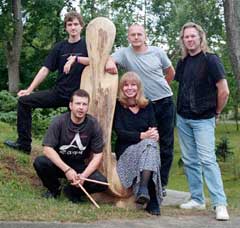Iļģi, Latvia’s leading folk music group, mark their 20th anniversary this year with a series of concerts abroad. Fresh from a trip to China, six members of the collective head this month to the United States for a two-week tour of Eastern and Midwestern venues. And, a week after they return to Rīga in early October, the band heads off to Norway, said Gatis Gaujenieks, the group’s bass player.
The U.S. tour will give non-Latvian audiences a chance to hear what “world music” sounds like from the Latvian perspective. Iļģi, who emerged from the early 1980s folk revival movement, have moved far from their roots. While other folk groups have joined Iļģi in seeking out unromanticized versions of Latvian folk songs, it is Iļģi who have pushed furthest into weaving into their repertoire other cultures’ folk influences, along with the sounds of modern rock music.
Founded in 1981 by Ilga Reizniece, Iļģi has seen band members come and go. The group’s early years were focused on retrieving traditional music styles that had been suppressed for many years. The group’s efforts at times were viewed suspiciously by Soviet authorities, who considered the period’s folk revival as unwelcome nationalism.
By the mid-1990s, Iļģi were experimenting with broader musical influences and moving into their “post-folk” period. While Reizniece’s voice and fiddle-playing and Māris Muktupāvels’ handling of the kokle remain integral to the band’s signature, bass, guitar and drums now round out the sound. Group members and the Iļģi sound also at times spilled over into the rock group Jauns Mēness, fronted by Ainars Mielavs, whose UPE record label has released the last two Iļģi albums.
Latvian audiences familiar with the band’s discography should expect to hear material from the last two albums, Saules meita (1998) and Sēju vēju (2000). Some new material also might be heard in the concerts, possibly including something from “Spēlēju, dancoju,” a rock opera based on the work of Latvian poet and writer Jānis Rainis, Gaujenieks said. The rock opera—a collaboration between Lithuania’s Miraklis “visual theatre” group and Latvia’s Jaunā teātra institūts—is scheduled to be performed Sept. 14 at the Daugavgrīva fortress on the outskirts of Rīga as part of the Homo Novus theatre festival. A live Webcast of the performance also is planned.
The band doesn’t know how audiences in the United States will react to the music, Gaujenieks said. In China, he said, Iļģi were generally received positively, except in one concert where the audience seemed apathetic.
Older members of Latvian audiences, Gaujenieks admitted in a telephone interview from Rīga, may not quite like what they hear. He recalled that the last time the band was in North America, playing a concert in Toronto, the reaction of some listeners was cool.
“Yes, we have heavy pieces, but we also have many light pieces,” Gaujenieks said. “But it’s 2001, and if we have a hope of Latvian folk music becoming popular in the world, we have to keep up with what’s happening.”
Among younger listeners in Latvia, Iļģi are the most popular folk artists. It’s important, he noted, that Latvian music maintain a foothold in a time when many radio stations are more focused on broadcasting the European version of the Billboard Top 100.
It’s still too early to tell whether Iļģi will please the ear of a North American producer who might give the band a record deal, but Gaujenieks said the tour will offer the band the rare opportunity to play at a number of folk festivals including Chicago’s World Music Festival, the Detroit Festival of Arts and Lotus Fest in Bloomington, Ind. In Minneapolis, the band will be the warm-up act for a Tuvan throat-singing group performing in the city’s leading world music venue, the Cedar Cultural Centre.
The band also is scheduled to play a number of Latvian community venues, where the full concert program is expected to give way to a more participatory atmosphere, with Iļģi teaching audience members Latvian folk dances and rotaļas (games).
For Gaujenieks, the U.S. tour will be a homecoming of sorts. The bass player was a member of Akacis, a popular early 1980s Latvian-American trimda rock band. Besides playing with Iļģi, he now runs the GEM recording studio in Rīga. Also on the U.S. tour will be fellow ex-Akacis member Jānis Abens who now lives in Sweden and is one of four guitarists who play with Iļģi.
Besides Reizniece (voice and fiddle), Muktupāvels (voice, kokle, bagpipes and accordeon), Gaujenieks (voice, bass and ģīga) and Abens (guitar), the other two band members on this American tour are Mikus Čavarts (percussion) and Vilijs Strods (drums).
The tour begins Sept. 13 with a concert in the Latvian Lutheran church near Washington, D.C., and continues on to New York City; Summit, N.J.; Detroit; Grand Rapids, Mich.; Cleveland; Indianapolis; Bloomington, Ind.; Chicago; Milwaukee; Minneapolis; back to Chicago, ending Sept. 30 in Kalamazoo, Mich.

Current band members include (seated in front) Vilijs Strods and Ilga Reizniece, and (standing, from left) Mikus Čavarts, Māris Muktupāvels and Gatis Gaujenieks. The wood sculpture symbolizes any of the four guitarists who regularly perform with Iļģi, said Gaujenieks. On this tour, it’s Jānis Abens from Sweden. (Photo courtesy of Iļģi)
© 1995-2024 Latvians Online
Please contact us for editorial queries, or for permission to republish material. Disclaimer: The content of Web sites to which Latvians Online provides links does not necessarily reflect the opinion of Latvians Online, its staff or its sponsors.




